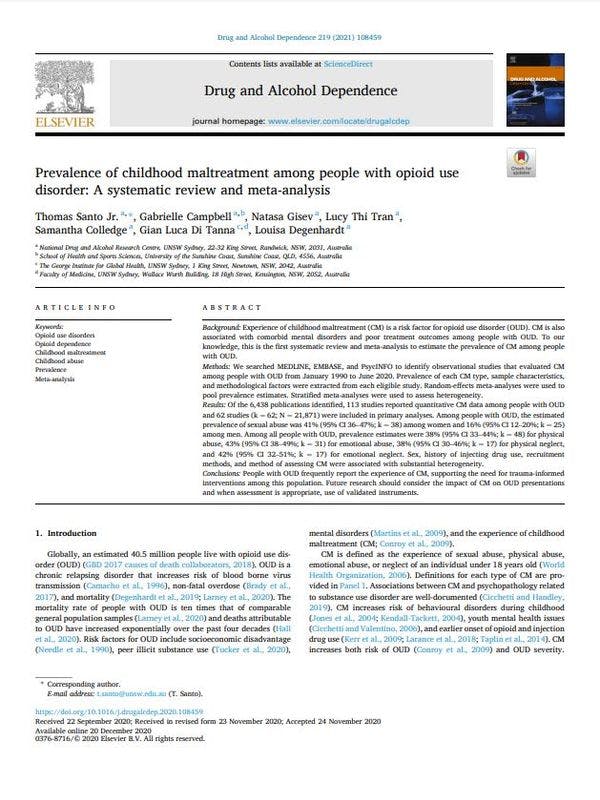Prevalence of childhood maltreatment among people with opioid use disorder: A systematic review and meta-analysis
By Thomas Santo Jr., Gabrielle Campbell, Natasa Giseva, Lucy Thi Tran, Samantha Colledge, Gian LucaD i Tanna, LouisaDegenhardt
Highlights
- Childhood maltreatment (CM) is common experience for people with opioid use disorder (OUD).
- Women with OUD experience childhood sexual abuse (41%) more often than men (16%).
- People with OUD often report childhood physical abuse (43%) and neglect (40%).
- Most studies evaluate childhood sexual or physical abuse among OUD treatment samples.
- “Gold standard” definitions of CM produce the highest prevalence rates of CM.
Abstract
Background
Experience of childhood maltreatment (CM) is a risk factor for opioid use disorder (OUD). CM is also associated with comorbid mental disorders and poor treatment outcomes among people with OUD. To our knowledge, this is the first systematic review and meta-analysis to estimate the prevalence of CM among people with OUD.
Methods
We searched MEDLINE, EMBASE, and PsycINFO to identify observational studies that evaluated CM among people with OUD from January 1990 to June 2020. Prevalence of each CM type, sample characteristics, and methodological factors were extracted from each eligible study. Random-effects meta-analyses were used to pool prevalence estimates. Stratified meta-analyses were used to assess heterogeneity.
Results
Of the 6,438 publications identified, 113 studies reported quantitative CM data among people with OUD and 62 studies (k = 62; N = 21,871) were included in primary analyses. Among people with OUD, the estimated prevalence of sexual abuse was 41% (95% CI 36–47%; k = 38) among women and 16% (95% CI 12–20%; k = 25) among men. Among all people with OUD, prevalence estimates were 38% (95% CI 33–44%; k = 48) for physical abuse, 43% (95% CI 38–49%; k = 31) for emotional abuse, 38% (95% CI 30–46%; k = 17) for physical neglect, and 42% (95% CI 32–51%; k = 17) for emotional neglect. Sex, history of injecting drug use, recruitment methods, and method of assessing CM were associated with substantial heterogeneity.
Conclusions
People with OUD frequently report the experience of CM, supporting the need for trauma-informed interventions among this population. Future research should consider the impact of CM on OUD presentations and when assessment is appropriate, use of validated instruments.
